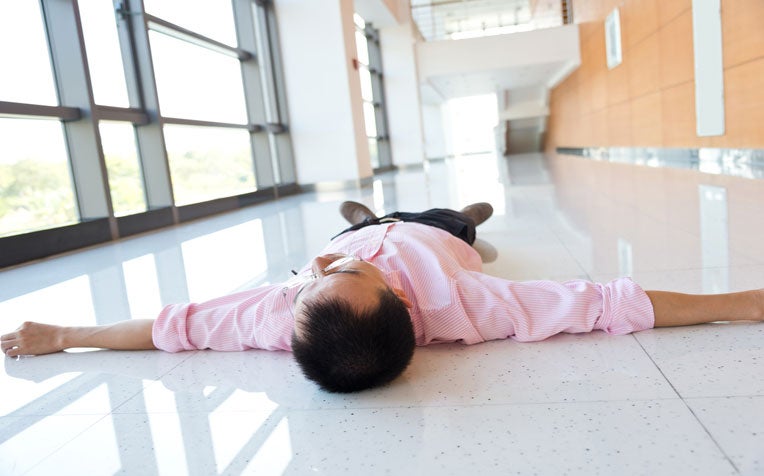
Fainting (known medically as syncope) could suggest other health conditions.
Did you know that fainting (syncope) may suggest an underlying medical problem?
Watching a sitcom character faint is often amusing. But in real life, fainting (also known as syncope) isn’t a laughing matter as it may suggest an underlying medical problem.
Dr Shah Mitesh and Dr Ian Phoon, Family Physicians at the Geylang and Pasir Ris Polyclinics respectively, SingHealth Polyclinics (SHP), members of the SingHealth group, provide insight into what causes fainting, what to do if a loved one faints, and precautionary steps to take if you suddenly start to feel faint.
But first things first: What is the proper course of action when you witness someone losing consciousness?
What to do when someone faints
Contrary to what you’ve seen on the television or in movies, there’s no need to slap or shake the person or splash water on them. Once the brain receives sufficient nutrients, the person will automatically regain consciousness.
The best way you can provide assistance would be to familiarise yourself with CPR (cardio-pulmonary resuscitation) or the use of the AED (Automated External Defibrillator). |
The AED (Automated External Defibrillator) is a portable electrical device that detects dangerous heart rhythms and delivers a current to “shock” the heart back into normal rhythm if there’s a need to.
In CPR, remember the acronym D-R-S-A-B-C:
D (Danger) – Ensure the area is safe for yourself and the person requiring help.
R (Response) – Check for a response from the person you’re helping (e.g. ask “What’s your name?” and “Are you ok?”) If there’s no response, call for help immediately. If there’s a response, help to make the person more comfortable.
S (Shout for help) – Shout for help or ask someone to call 995 for an ambulance.
A (Airway) – Check the person’s airway to ensure there’s no blockage.
B (Breathing) – Check for breathing. If breathing is not normal, begin CPR. If breathing is normal, continue to monitor breathing and check for injuries.
C (Circulation) – Check for the pulse. Usually, if there's no breathing, it can be assumed that there's also no pulse, and CPR should begin: 30 chest compressions for every 2 breaths. Perform CPR until help arrives or the person recovers.
Other ways to help someone that has fainted include:
Allow the person to lie down and rest. Do not make them sit up immediately.
Turn the person to one side to prevent the tongue or mouth secretions from obstructing the airway.
Take note if the person exhibits any unusual jerking motion.
Continue to monitor the person until the ambulance arrives, or till the person wakes up spontaneously.
What to do if you feel faint
Try to call for help immediately. If there’s no one around, call 995 for an ambulance.
As the most common cause of fainting is vasovagal, the best thing to do is to sit, squat or lie down.
If you have diabetes and are on oral diabetic medication, and have missed or delayed a meal, quickly suck on a sweet as you may have low blood sugar.
Click here for how to manage hypoglycaemia (low blood glucose).See a doctor as soon as possible.
How does fainting (syncope) come about?
Fainting generally refers to a momentary loss of consciousness. This generally occurs when the brain doesn’t receive enough oxygen, blood or sugar. In the case of fits, fainting is due to a surge of electrical impulses originating from the brain.
The typical fainting spell is the result of the body overreacting to certain triggers, such as the sight of blood or extreme emotional distress. This is called a “vasovagal syncope”.
During such an episode, the vagal nerve (from the brain) causes the heart rate and blood pressure to drop, reducing blood flow to the brain. Since blood carries oxygen to the brain, this deprives the brain of oxygen, leading to a “black-out”.
When someone faints, the body typically goes from a standing to a lying position. This helps the blood to flow to the brain since the blood doesn’t need to be pumped against gravity. The person will often regain consciousness spontaneously after a few minutes.
How serious is fainting?
Most cases of fainting are benign, but this should never be assumed. Syncope could mean a serious – even potentially fatal – condition such as irregular heartbeats, epilepsy, very low blood sugar (hypoglycaemia), sudden blood loss or cardiac arrest. If you lose consciousness, you should be properly assessed by a medical practitioner.
Ref: H24 (ed)
Other articles you may be interested in:
Burns and Scalds: How To Treat and When To See a Doctor
Treatments for Common Injuries at Home
Contributed by














 Get it on Google Play
Get it on Google Play